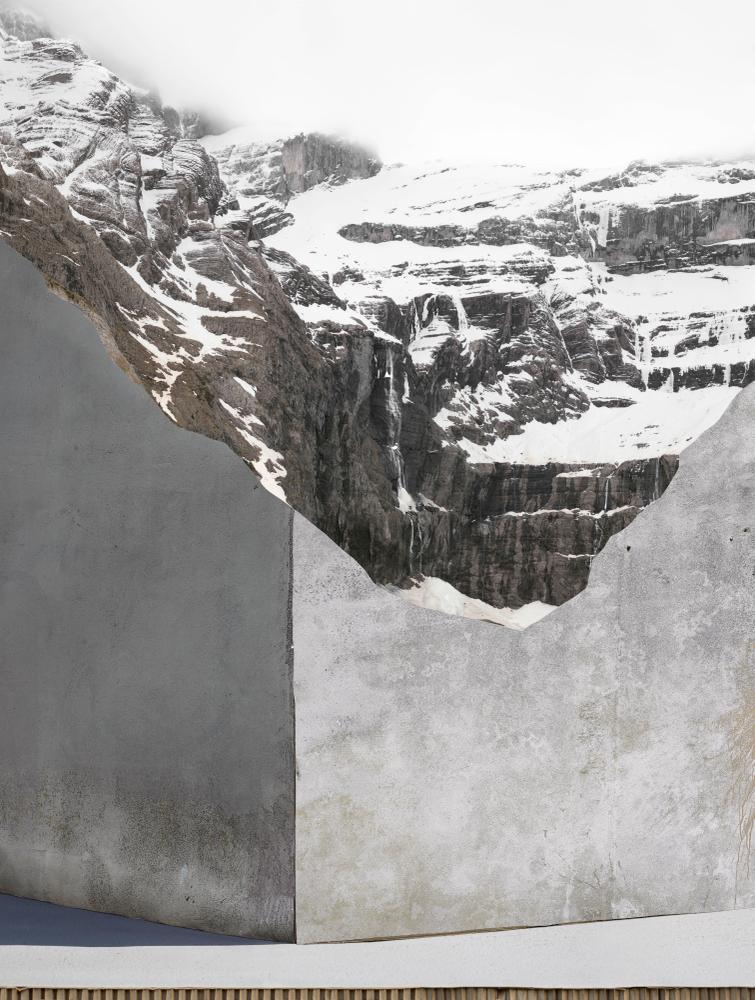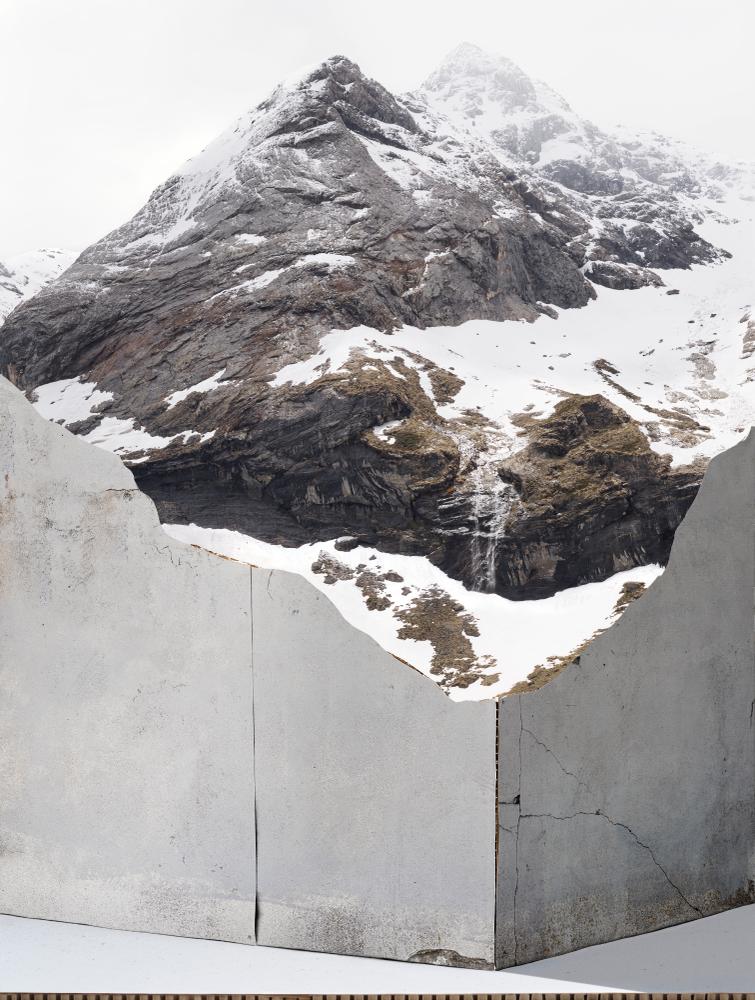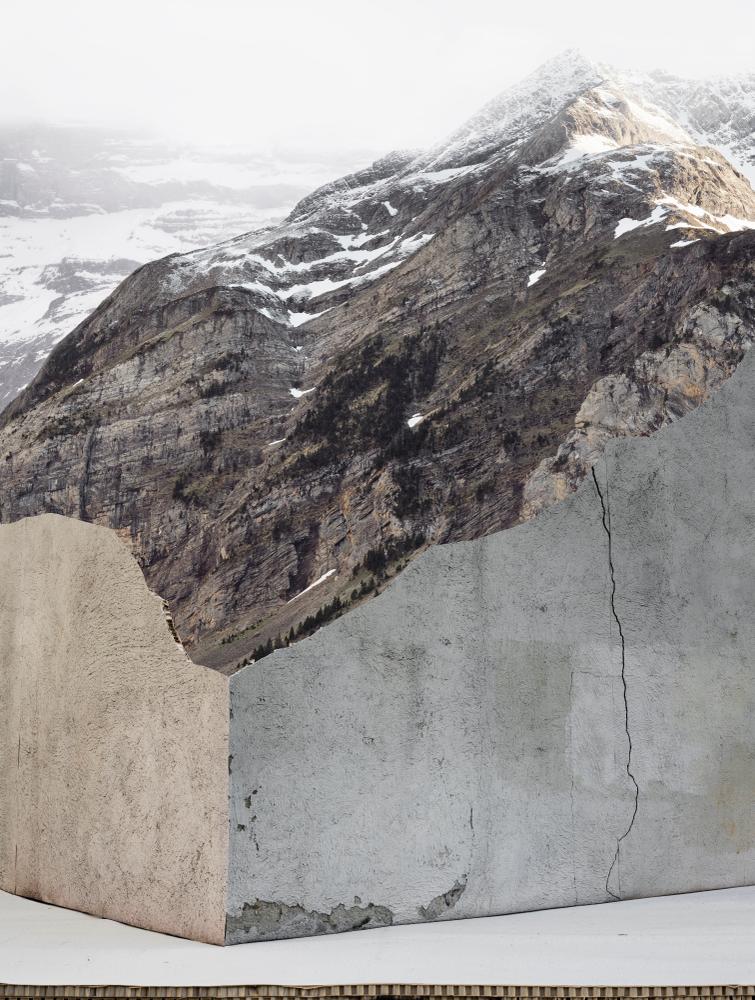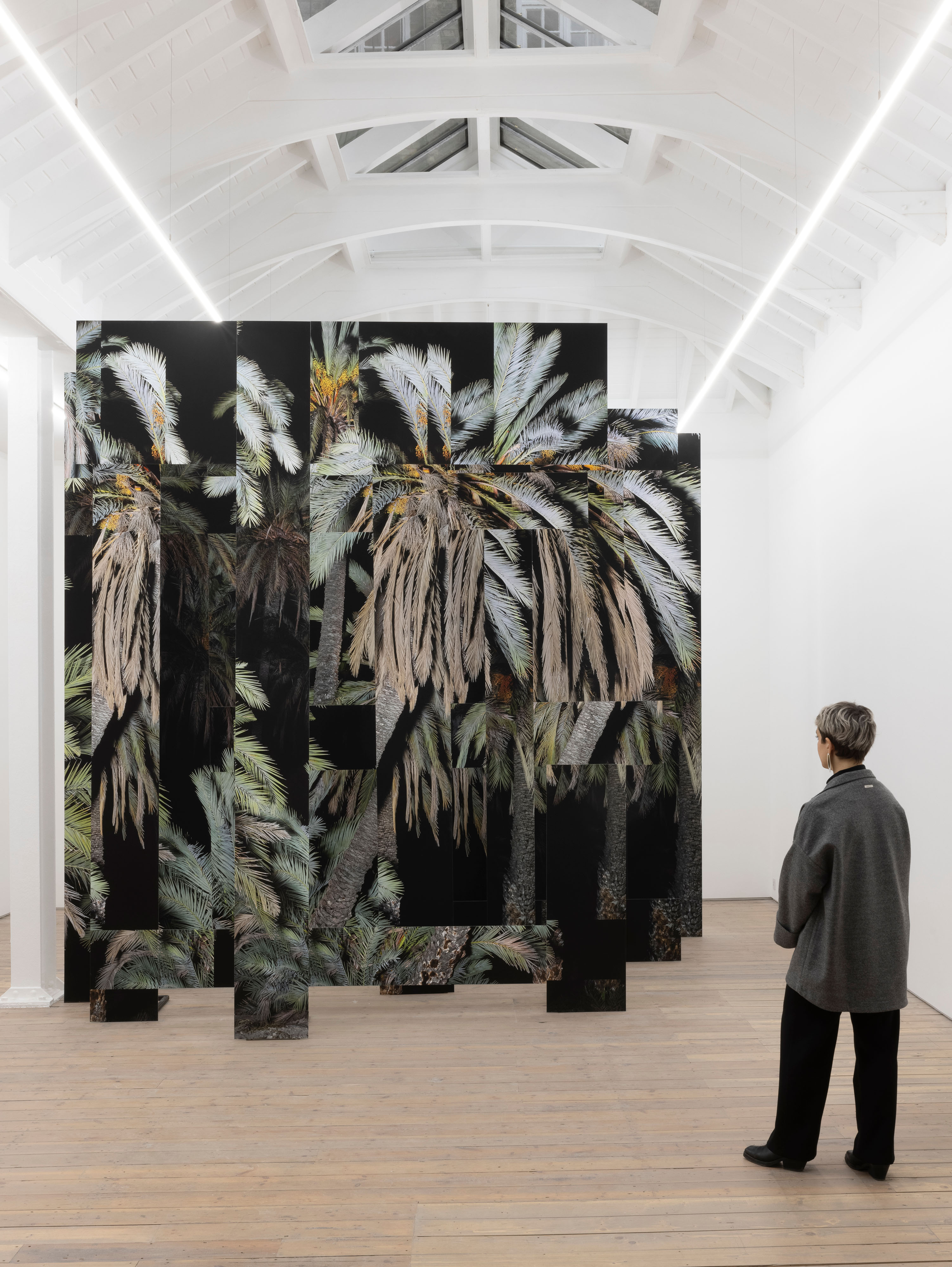Noémie Goudal’s layering landscapes & theatrical places
In the opening exhibition at Edel Assanti’s new Sanchez Benton designed space, artist Noémie Goudal uses film & photography to question time, nature, and our human relation to it.
Upon entering, a visitor to Noémie Goudal’s exhibition Post
Atlentica is faced with a large, seemingly impenetrable wall of foliage. Gleaming
white walls of the gallery starkly framing a natural barrier, which has
something of the glitch about it, a repeating or overlapping structure.
![]()
Walking deeper into the space that structure, which Goudal has called Untitled (Giant Phoenix), becomes more visible, the ceiling-high images in fact made of tall flat panels at varying depths into the room, held up by a rigid metal framework. From behind, the romance is gone, the photo-sculpture more akin to the rear of a motorway direction sign than the alluring, exotic planting of the front.
In the adjoining room, beyond the sliced trees, three large photographs of mountains. But, looking again, something isn’t right – these are manufactured landscapes, each mountain seemingly cut out of a concrete block, sharp vertical sides turning geology into a kind of pre-packaged, transportable souvenir of place, at an indistinguishable scale, maybe 1:1. The mountains are in fact photographs from the French region of Morbihan, the peaks arriving to their current situation after a 300,000 year slow journey.
![]()
![]()
![]()
figs.ii-iv
The gallery this uncanny, flattened foliage and archaeological slices sit within is a new space for Edel Assanti, designed by London architects Sanchez Benton. It’s a simple, traditionally white-walled space which is broken into three distinct public rooms – two on the ground floor, each with frontages onto parallel streets, and a basement.
It’s from that lower space that a grumbling, scratching, awkward noise rises. It’s an invitation deeper, but one that also questions if you really want to descend. Once there, the visitor is confronted by a looping film, clearly of the same visual language as the upstairs framework-sculpture. The grating and mechanical sounds are jarring against the natural scene. But what is the nature presented? Flat elevations of trees, planting, and growths are slowly shifted into place from unseen cranes, as if elements of scenery over a theatrical interval, preparing for Act 2.
The elements being montaged into place might even be 1:1 photographic reproductions of the nature within the wider frame we are looking at, perhaps a simulacrum of place slowly dropping in front of the place itself. Nature is hoisted lower until it touches and semi-submerges into a watery bog. More drop into place, the wetness concealed by these representations of a nature. When a flat stops moving, and sits motionless against the stillness of its landscape, it appears to gradually absorb into the setting – the edge between real and reproduced softens to the eye. Just when it feels that the scene is fixed, and our new sense of place is formed, the images start to shift again – this time dropping deeper into the water, submerging and returning the landscape back to its marshy, de-humaned state.
![]()
The film is Inhale, Exhale (2022). It speaks to the
changing nature of landscapes – natural, to man-affected, then to reclamation
into primordial state. Goudal’s work draws from the Arctic 18,000 years ago,
when over the ice-age humans crossed into the American continent. The Baring
Sea froze, and connection was made long enough for animals – including humans –
to cross, before it returned again to water.
The noises which leaked upstairs seem to form a sonic amalgamation of theatrical machinery and tectonic noises of geological and atmospheric shifts. The nature of the changing scene seems to connect to the upstairs work through a sense of landscape performativity, inviting us to ask what is nature, as well as what is product and what is artifice. Place is nearly always an amalgamation of all three, and loading much more in besides. Goudal is interested in a deep-time, reflecting on an archaeological reading of landscape and time, with the more recent human intervention, reforming, and recreating of nature but a blip in their story, but one perhaps forming the only lens we can imagine them through.
![]()
fig.vi

fig.i
Walking deeper into the space that structure, which Goudal has called Untitled (Giant Phoenix), becomes more visible, the ceiling-high images in fact made of tall flat panels at varying depths into the room, held up by a rigid metal framework. From behind, the romance is gone, the photo-sculpture more akin to the rear of a motorway direction sign than the alluring, exotic planting of the front.
In the adjoining room, beyond the sliced trees, three large photographs of mountains. But, looking again, something isn’t right – these are manufactured landscapes, each mountain seemingly cut out of a concrete block, sharp vertical sides turning geology into a kind of pre-packaged, transportable souvenir of place, at an indistinguishable scale, maybe 1:1. The mountains are in fact photographs from the French region of Morbihan, the peaks arriving to their current situation after a 300,000 year slow journey.



figs.ii-iv
The gallery this uncanny, flattened foliage and archaeological slices sit within is a new space for Edel Assanti, designed by London architects Sanchez Benton. It’s a simple, traditionally white-walled space which is broken into three distinct public rooms – two on the ground floor, each with frontages onto parallel streets, and a basement.
It’s from that lower space that a grumbling, scratching, awkward noise rises. It’s an invitation deeper, but one that also questions if you really want to descend. Once there, the visitor is confronted by a looping film, clearly of the same visual language as the upstairs framework-sculpture. The grating and mechanical sounds are jarring against the natural scene. But what is the nature presented? Flat elevations of trees, planting, and growths are slowly shifted into place from unseen cranes, as if elements of scenery over a theatrical interval, preparing for Act 2.
The elements being montaged into place might even be 1:1 photographic reproductions of the nature within the wider frame we are looking at, perhaps a simulacrum of place slowly dropping in front of the place itself. Nature is hoisted lower until it touches and semi-submerges into a watery bog. More drop into place, the wetness concealed by these representations of a nature. When a flat stops moving, and sits motionless against the stillness of its landscape, it appears to gradually absorb into the setting – the edge between real and reproduced softens to the eye. Just when it feels that the scene is fixed, and our new sense of place is formed, the images start to shift again – this time dropping deeper into the water, submerging and returning the landscape back to its marshy, de-humaned state.

fig.v
The noises which leaked upstairs seem to form a sonic amalgamation of theatrical machinery and tectonic noises of geological and atmospheric shifts. The nature of the changing scene seems to connect to the upstairs work through a sense of landscape performativity, inviting us to ask what is nature, as well as what is product and what is artifice. Place is nearly always an amalgamation of all three, and loading much more in besides. Goudal is interested in a deep-time, reflecting on an archaeological reading of landscape and time, with the more recent human intervention, reforming, and recreating of nature but a blip in their story, but one perhaps forming the only lens we can imagine them through.

fig.vi
Noémie Goudal has a practice involving the construction of ambitious staged, illusionistic installations within the landscape, documented using film and photography. Goudal’s interventions are under pinned by rigorous research examining the intersection of ecology and anthropology, interrogating the limitations of theoretical conceptions of the natural world. Noémie Goudal (b. 1984) graduated from the Royal College of Art (UK) in 2010 with an MA in Photography.
www.noemiegoudal.com
Edel Assanti was founded in 2010 by Jeremy Epstein and Charlie Fellowes. The gallery works with international artists whose practices engage with the social, cultural or political realities of the moment in which they live. Their programme’s tendency towards interdisciplinary, research-led work demonstrates how artists are uniquely positioned to witness and distill the complex narratives that define our era.In January 2022, they opened their new 4,000 square foot gallery designed by architects Sanchez Benton in a historic listed building on Little Titchfield Street.
www.edelassanti.com
images
fig.i Installation View of Noémie Goudal_ Post Atlantica at Edel Assanti, 2022 © Will Amlot
figs.ii-iv Noémie Goudal_Mountains (Triptych I) (2021)
© Noémie Goudal
figs.v-vi Installation Views of Noémie Goudal_ Post Atlantica at Edel Assanti, 2022 © Will Amlot
publication date
22 February 2022
tags
Archaeology, Edel Assanti, Film, Noémie Goudal, Landscape, Nature, Photography, Sculpture, Time
figs.ii-iv Noémie Goudal_Mountains (Triptych I) (2021) © Noémie Goudal
figs.v-vi Installation Views of Noémie Goudal_ Post Atlantica at Edel Assanti, 2022 © Will Amlot
publication date
22 February 2022
tags
Archaeology, Edel Assanti, Film, Noémie Goudal, Landscape, Nature, Photography, Sculpture, Time


